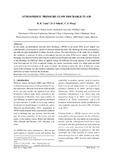Please use this identifier to cite or link to this item:
https://elibrary.khec.edu.np:8080/handle/123456789/103Full metadata record
| DC Field | Value | Language |
|---|---|---|
| dc.contributor.author | Dr; Tyata, Raju Bhai | - |
| dc.contributor.author | Subedi, D.P. | - |
| dc.contributor.author | wong, C.S. | - |
| dc.date.accessioned | 2022-04-10T10:52:53Z | - |
| dc.date.available | 2022-04-10T10:52:53Z | - |
| dc.date.issued | 2068 | - |
| dc.identifier.uri | https://doi.org/10.3126/jsce.v1i0.22490 | - |
| dc.description | JScE Vol.I | en_US |
| dc.description.abstract | In this study, an atmospheric pressure glow discharge (APGD) in air using 50Hz power supply was experimentally investigated by means of electrical characterization. The discharge has been generated in a specially designed hemispherical–plane electrode system. The main objective of the study was to identify the conditions to generate AC glow at atmospheric pressure air using 50 Hz power supply. The mode of discharge was characterized by observing the number of current pulses per half cycle in the current waveform of the discharge for different values of applied voltage for different electrode spacing. It was found that with 3mm gap and 18.75 kV of applied voltage, the current waveforms consist of a single pulse per half cycle indicating the formation of AC glow discharge. An attempt to study the effect of dielectric on the mode of the discharge was also made by using three types of materials namely Polycarbonate, Polyethylene and Glass as barrier between the electrodes. | en_US |
| dc.language.iso | en | en_US |
| dc.subject | Electrical discharge, APGD, Asymmetric electrode, Without dielectric, Air | en_US |
| dc.title | ATMOSPHREIC PRESSURE GLOW DISCHARGE IN AIR | en_US |
| dc.type | Article | en_US |
| Appears in Collections: | Journal of Science and Engineering Vol.1 | |
Files in This Item:
| File | Description | Size | Format | |
|---|---|---|---|---|
| R. B. Tyata1,2, D. P. Subedi1, C. S. Wong3.pdf | JScE Vol.I | 700.68 kB | Adobe PDF |  View/Open |
Items in DSpace are protected by copyright, with all rights reserved, unless otherwise indicated.
